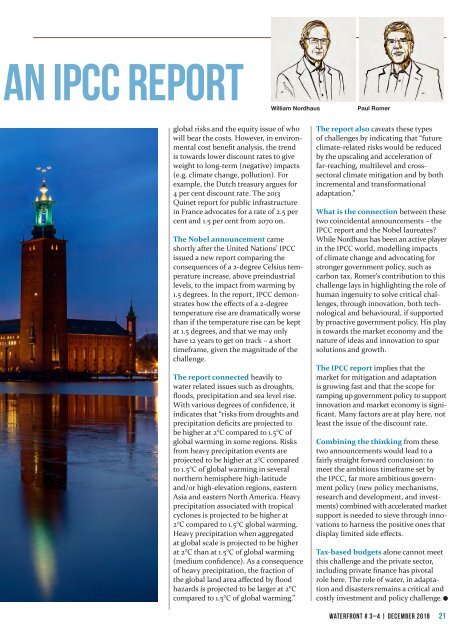Water Front #3-4 2018
Create successful ePaper yourself
Turn your PDF publications into a flip-book with our unique Google optimized e-Paper software.
AN IPCC REPORT<br />
William Nordhaus<br />
Paul Romer<br />
global risks and the equity issue of who<br />
will bear the costs. However, in environmental<br />
cost benefit analysis, the trend<br />
is towards lower discount rates to give<br />
weight to long-term (negative) impacts<br />
(e.g. climate change, pollution). For<br />
example, the Dutch treasury argues for<br />
4 per cent discount rate. The 2013<br />
Quinet report for public infrastructure<br />
in France advocates for a rate of 2.5 per<br />
cent and 1.5 per cent from 2070 on.<br />
The Nobel announcement came<br />
shortly after the United Nations’ IPCC<br />
issued a new report comparing the<br />
consequences of a 2-degree Celsius temperature<br />
increase, above preindustrial<br />
levels, to the impact from warming by<br />
1.5 degrees. In the report, IPCC demonstrates<br />
how the effects of a 2-degree<br />
temperature rise are dramatically worse<br />
than if the temperature rise can be kept<br />
at 1.5 degrees, and that we may only<br />
have 12 years to get on track – a short<br />
timeframe, given the magnitude of the<br />
challenge.<br />
The report connected heavily to<br />
water related issues such as droughts,<br />
floods, precipitation and sea level rise.<br />
With various degrees of confidence, it<br />
indicates that “risks from droughts and<br />
precipitation deficits are projected to<br />
be higher at 2°C compared to 1.5°C of<br />
global warming in some regions. Risks<br />
from heavy precipitation events are<br />
projected to be higher at 2°C compared<br />
to 1.5°C of global warming in several<br />
northern hemisphere high-latitude<br />
and/or high-elevation regions, eastern<br />
Asia and eastern North America. Heavy<br />
precipitation associated with tropical<br />
cyclones is projected to be higher at<br />
2°C compared to 1.5°C global warming.<br />
Heavy precipitation when aggregated<br />
at global scale is projected to be higher<br />
at 2°C than at 1.5°C of global warming<br />
(medium confidence). As a consequence<br />
of heavy precipitation, the fraction of<br />
the global land area affected by flood<br />
hazards is projected to be larger at 2°C<br />
compared to 1.5°C of global warming.”<br />
The report also caveats these types<br />
of challenges by indicating that “future<br />
climate-related risks would be reduced<br />
by the upscaling and acceleration of<br />
far- reaching, multilevel and crosssectoral<br />
climate mitigation and by both<br />
incremental and transformational<br />
adaptation.”<br />
What is the connection between these<br />
two coincidental announcements – the<br />
IPCC report and the Nobel laureates?<br />
While Nordhaus has been an active player<br />
in the IPCC world, modelling impacts<br />
of climate change and advocating for<br />
stronger government policy, such as<br />
carbon tax, Romer’s contribution to this<br />
challenge lays in highlighting the role of<br />
human ingenuity to solve critical challenges,<br />
through innovation, both technological<br />
and behavioural, if supported<br />
by proactive government policy. His play<br />
is towards the market economy and the<br />
nature of ideas and innovation to spur<br />
solutions and growth.<br />
The IPCC report implies that the<br />
market for mitigation and adaptation<br />
is growing fast and that the scope for<br />
ramping up government policy to support<br />
innovation and market economy is significant.<br />
Many factors are at play here, not<br />
least the issue of the discount rate.<br />
Combining the thinking from these<br />
two announcements would lead to a<br />
fairly straight forward conclusion: to<br />
meet the ambitious timeframe set by<br />
the IPCC, far more ambitious government<br />
policy (new policy mechanisms,<br />
research and development, and investments)<br />
combined with accelerated market<br />
support is needed to sieve through innovations<br />
to harness the positive ones that<br />
display limited side effects.<br />
Tax-based budgets alone cannot meet<br />
this challenge and the private sector,<br />
including private finance has pivotal<br />
role here. The role of water, in adaptation<br />
and disasters remains a critical and<br />
costly investment and policy challenge.<br />
WATERFRONT # 3–4 | december <strong>2018</strong><br />
21


















